#Spanish Picual Extra Virgin Olive Oil
Text
Buy Spanish Picual Extra Virgin Olive Oil
Indulge in the rich flavors of our Spanish Picual Extra Virgin Olive Oil. Sourced from premium olives, this exquisite oil elevates your culinary creations. Elevate your dishes with the authentic taste and health benefits of this liquid gold. Buy now and savor the essence of Mediterranean excellence.
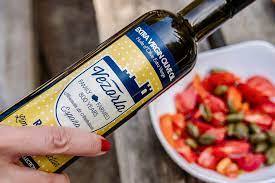
0 notes
Text
What kind of olives yield Extra Virgin Olive Oil?
Extra Virgin Olive Oil (EVOO) is made from the first pressing of olives, and it must meet certain quality standards to be classified as "extra virgin." The type of olives used to produce extra virgin olive oil can vary, as different olive varieties have distinct flavors, aromas, and characteristics. Some common olive varieties used to produce EVOO include:
Arbequina: These olives are small and fruity, often producing oils with a mild and delicate flavor.
Picual: This is a widely cultivated olive variety, particularly in Spain. Picual olives often result in oils with a robust, peppery, and slightly bitter flavor profile.
Hojiblanca: Another prominent Spanish variety, Hojiblanca olives contribute to oils with a fruity and slightly bitter taste.
Koroneiki: Commonly grown in Greece, the Koroneiki olive is known for producing oils with a robust and peppery flavor.
Frantoio: Originating from Italy, Frantoio olives are often used in the production of high-quality olive oils with a balanced and fruity taste.
Leccino: Another Italian variety, Leccino olives are known for producing oils with a mild and fruity profile.
The flavor of extra virgin olive oil is influenced by factors such as the olive variety, climate, soil conditions, and the timing of the harvest. Early-harvest olives tend to produce oils with more robust and peppery characteristics, while late-harvest olives may result in milder oils.
It's worth noting that the term "extra virgin" signifies the highest quality of olive oil, and it is extracted using mechanical means (pressing or centrifugation) without the use of heat or chemicals. Additionally, the oil must meet specific chemical and sensory criteria, including low acidity and a favorable taste profile, to be classified as extra virgin.
0 notes
Text
Ubeda, Spain
August 12-14 2023
After having our minds blown in Cordeba, we headed to Ubeda - a tiny village located in the "Mer de Olives" - the sea of olives. Spain has 300 MILLION plus olive trees and I'm not kidding. One can travel miles and miles and miles and see only olive groves.



We are in the region (think “state”) of Andalusia and we have been here for most of our time in Spain, so far.

Úbeda is a municipality of Spain of 35,000 people located in the region of Andalusia. The town lies on the southern ridge of the Sierra Nevada's so-called Loma de Úbeda, a table sandwiched in between the Guadalquivir and the Guadalimar river beds.
The Parador de Úbeda was the first palace converted into a Parador in Spain in 1910 and is located in a former palace which belonged to the dean of the Sacred chapel of El Salvador. It was built in the 16th century and altered in the 17th century. It is beautiful.


Our room:


And the view from both our balconies:


The beautiful Church of San Salvador! The photo below shows are parador to the left of the church and in the shade. Our room is in the upper corner by the church.
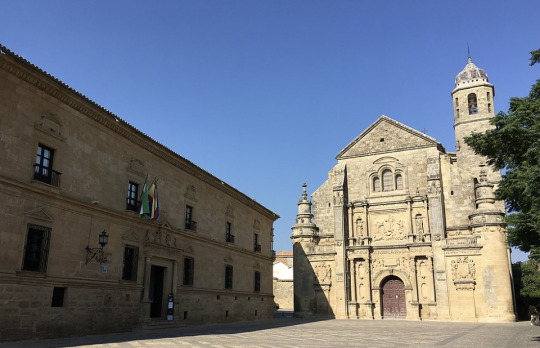
From the website:
The building, of Renaissance architecture, stands out for its façade and the splendid central patio, one of the most beautiful in Úbeda. The large windows on the façade flood the interior with light, where the elegant rooms and majestic halls are fully equipped for holding meetings and events.
Úbeda was declared a World Heritage City for its Renaissance monumental complex. A walk through its historic center explains this title granted by the heritage and historical wealth found in its streets, palaces, churches and museums. The city is also rich in crafts, gastronomy and Andalusian folklore. The title is shared with the city of Baeza, also notable for its Renaissance monumental complex and located a few kilometers from Úbeda.
The Parador Ubeda is the former palace of Don Fernando Ortega Salido. Originally a Moorish palace – he had it rebuilt to his liking – then had the chapel built right next to it. Hemingway, Pio Baroja, Garcia Lorca, and Paul Bowles have all stayed here at the Parador, so it has attracted a particularly literary crowd!
We took a little walk around the place town and then had dinner and went to bed. We had a big day the next day exploring the olive oil process. This begins with us going into the groves and picking the olives.
Below is Ken, olive gatherer extraordinaire, holding his high tech olive harvesting tool and his trusted assistant, Judith.
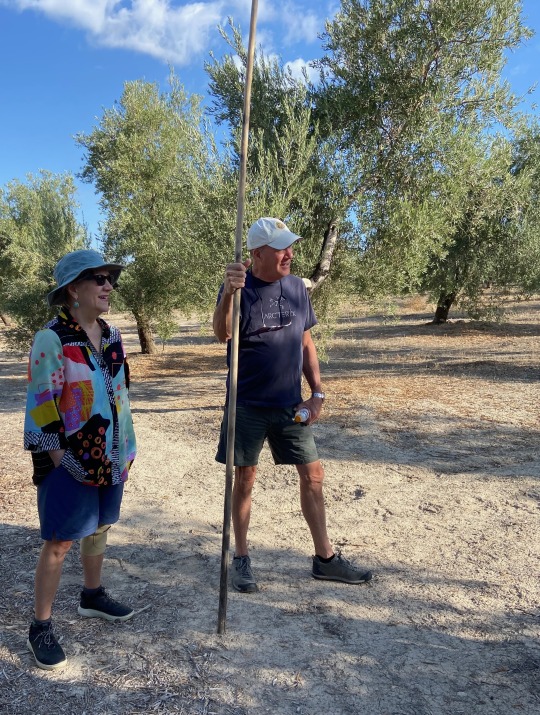
Next lay out the net...
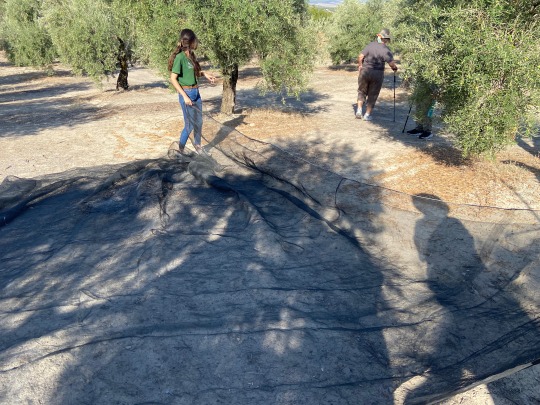
And get some instructions on what to do and what to pick and not pick...
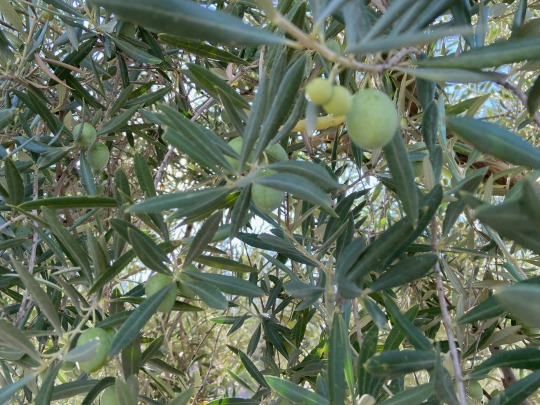
Then the "combing" begins...

Lots of people used the high tech tool - but Mark just used the walking sticks - Amateur!

Lots of people got into the action and we got a pretty good crop. Then we gathered up our olives

And I snapped this. I have entitled it "Spanish Gothic"

We also visited an olive tree that was 200 years old and still producing olives. I'm impressed!

This might look - to the untrained eye - liike it is 4 trees - but nope - one root. Next step - take the booty to the factory to turn those olive into olive oil.

George is the designated "pourer" and the process begins. We didn't just go so some ol' olive oil producer, we visited the producer that won the grand prize for the best Olive Oil for 2023, Oleícola San Francisco Olive Oil Factory.

We learned that a black olive and a green olive are the same - just in different stages of ripening. The are more than 700 varieties of olives but we picked Picual Olives. There are only three types of olive oil - 1. Extra Virgin. 2. Virgin and 3 Lambaste (DO NOT EAT THIS!!). Extra Virgin must be perfect in lots of categories and have no chemical and process with no heat. Virgin is just not quite Extra Virgin and the last is used for lots of things - but is low quality and should not be eaten. I wrote "should" because while it is illegal to sell for consumption in the EU - it is not illegal in the lots of other places - like the US. If the bottle says "Olive Oil" you are getting Lambaste. Or CRAP! We also learned they harvest from October to January - but depending on weather it may be September to February. They went through every step which was fascinating - BUT I found this YouTube that can tell you much better than I can. Two things... She begins the video right outside our parador AND she doesn't know that in Spain - you do NOT say "hasta la vista" (as in the Terminator.). I'm sure you say many other farewell greetings - but all I can think of now is "Adios." But despite those things - this video is great!
youtube
After the process was explained to us - we tasted some oil, (spoiler alert - the one in the blue glass is the best in the world.)

Next, we went to work making lunch. It was so much fun!
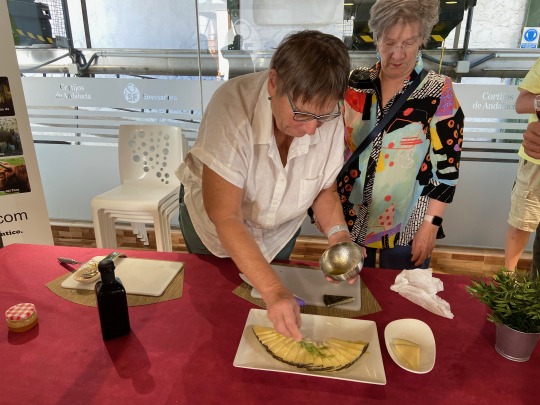
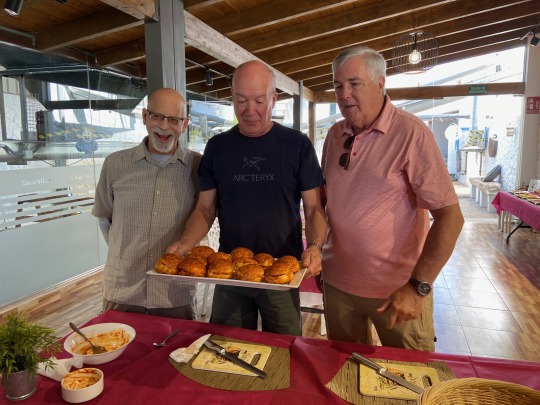
We made a delicious salad - but I took no pics of that. :(

Lunch was great and then with our newly found knowledge and some olive oil, we headed back to Ubeda. After our seista - i could get real use to this - FYI - we took a nice walk around the city stopping at a a potters shop who is bringing back pottery of the past - like this birthing pot.

The midwife is there to catch the baby - but this cuts down on the mess. Used centuries ago - this potter is bringing back the vessel. I'll get back you on how I feel about this.
We continued our walk until Carolina had another edible discovery, churros and hot chocolate. Both the churros and hot chocolate were different for the things we know in the states.


The churros in the US are covered with cinnamon and sugar - but not here. The hot chocolate here is like a warm chocolate pudding. I heard rave review.
For dinner, Joe, Daphne, Mark and I did a supermarket run and did wine, cheese and jamon in the room. We didn't START in the room, we started in the courtyard after I made sure it was OK - but then - when we were almost done - the guy who told me it was OK - came toward us waving his hands - saying "FORBIDDEN!!! No big deal - be packed up and went to our room. You can't scare us!
Ubeda was a wonderful place and we loved our time there - but tomorrow we leave for Toledo.
We are loving Spain.
Stay tuned.
0 notes
Text
Oro Bailen Olive Oils
Oro Bailen Olive Oils

Just like wine, extra virgin olive oil or EVO as it is called in the catering business can have very different characteristics, depending on soil, age, type of olive tree, climate, harvesting methods and even the altitude the olives are grown at.
Most supermarkets offer upmarket deluxe types of olive oil, you know the type, fancy bottles of olive oil by brands you have never heard of. So as a…
View On WordPress
#Andalusia#Arbequina Olives#chef kevin ashton#Christmas gifts#extra virgin olive oil#Foodie ideas#Jaen province#La Casa del Agua#Los Juncales#olive trees#Oro Bailen Olive Oils#Oro Bailen Reserva Familiar Picual#Picual Olives#Spanish olive oil#Xmas Gift Idea#厨师凯文·阿什顿
1 note
·
View note
Text
8 Spanish Dishes You Must Try At Least Once
Spain is made up of many different regions. And, as in many other countries, each of which has their own distinctive flavor and cuisine. I discovered the many delicious offerings of the Iberian Peninsula while traveling in Spain one summer. Moreover, I was quick to attempt the replication of many of the dishes I will mention as soon as I returned home. So I made sure I brought with me the best extra virgin olive oil Picual. While many different foods that are considered to be Spanish have originated in specific regions of the country, the foods I mention below were some of my favorite. Whether you are planning a trip to Spain, or a trip to your local Spanish restaurant, you absolutely must try some of these.
Paella
Una publicación compartida de arantxabrujilla (@arantxabrujilla) el 18 de Oct de 2017 a la(s) 6:17 PDT
Paella is traditionally a dish that is cooked in large quantities over an open fire outdoors, often for celebrations or gatherings. This dish has existed in the Iberian Peninsula in one form or another since around the 10th century and utilizes the short-grained Bomba rice. Some of the original traditional ingredients that were often used in paella are rabbit, snails, and beans. Today there are many more variations of paella. For example: vegetable paella, seafood paella or chicken paella. Aside from the rice, the one ingredient that remains necessary is the saffron, which gives the dish its characteristic yellow hue.
Valencia is considered to be the native home to the dish. A traditional Valencian paella would include a combination of the following ingredients: chicken, rabbit, snails, duck, great northern beans, artichoke, runner beans, and tomatoes. Throughout Spain, however, mixed paella (combining seafood with meat from land animals) is becoming more and more popular.
TAKEAWAY: Two years ago the Valencian company “Arroz La Fallera” launched a campaign so that a paella emoji was created. Unicode told them that, for it to become an emoji, there needed to exist some social demand. Therefore, La Fallera created the hashtag #paellaemoji, and it got to be a global trending topic not once, but twice! After all that noise, Unicode couldn’t deny it anymore, and now Spaniards have their own paella emoji. Way to go!

Tortilla de Patatas
Una publicación compartida de Tortilla De Patatas (@tortillapatatas) el 18 de Oct de 2017 a la(s) 10:06 PDT
This dish is one of my personal favorites; it was a staple in my diet when I was traveling in Spain. Spanish tortilla is like an omelet, or a crustless quiche, that is made from eggs and potatoes. It can sometimes also include onions. And when served as a tapa or pintxo, it can have different toppings like ham and cheese, mushrooms, chorizo, peppers, etc.
It is known as Tortilla Española, as a way to distinguish it from the maize or wheat tortilla used in many Central American cuisines. Although, if you are in Spain and see “tortilla” on the menu, this is what they are referring to. For this dish, the potatoes are either thinly sliced or diced into small cubes, seasoned, and then sauteed in olive oil with onions. Then, it is all mixed with beaten eggs.
Gambas al Ajillo
View this post on Instagram
A post shared by Montse Palet (@mpaletgo)
This popular shrimp dish is found more in the southern and central parts of Spain, especially in Andalusia. The reason for this is that, in the coastal regions of that area, they fish high-quality red shrimps. In its purest form, gambas al ajillo consists of shrimp, garlic, and olive oil, but there are many variations. This dish is typically ordered as an appetizer, but due to its popularity, you can often get it as an entree. You might also see it with parsley and chili peppers for a spicier version.
Queso Manchego
Una publicación compartida de Queso Manchego Las Terceras (@quesos_lasterceras) el 14 de Oct de 2017 a la(s) 3:36 PDT
Manchego is a delicious cheese made from sheep’s milk in La Mancha region of Spain. This cheese can be aged anywhere from 60 days all the way to 3 years, and the price will vary accordingly. The flavor of the cheese is fairly mild with a slight briny nuttiness and rather dry, which makes it a perfect compliment to a more fruity Spanish wine!
You can tell a traditional Manchego from the zigzag cross hatch pattern on the rind that is formed by the original presses. Manchego is everywhere in the markets in Spain and is often served as an appetizer all by itself, or sometimes with Andalusian olives in olive oil with garlic and lemon. Manchego is usually cut in thin triangular shaped pieces, as it would be cut from the wedge right from the whole wheel of cheese.
Lomo Ibérico
Una publicación compartida de Anne Stolbowsky (@anne_bcn) el 4 de Jul de 2017 a la(s) 3:02 PDT
This delicious dry-cured pork loin is a great compliment to the previously mentioned Manchego. The pork is usually seasoned with paprika, a staple in many Spanish dishes, and then cured for about three months. It emerges a deliciously marbled sausage that has smoky aromas and flavors. Lomo Ibérico is served at room temperature and thinly sliced. Although, sometimes, the lomo can be presented in a “tabla” (a wooden board) accompanied by jamón ibérico, chorizo, and salchichón. The top 4 of Spanish Iberian cured meats.
Pimientos de Padrón
Una publicación compartida de Markus Heiliö (@mheilio) el 21 de Jun de 2017 a la(s) 9:28 PDT
These are small peppers of varying shades of green that hail from the area of Padron (north-western Spain). They are usually fairly mild. However, one in about ten ends up being quite hot. That’s why Spaniards always say: “Pimientos del Padrón, unos pican y otros no,” which literally means “Padron peppers, some burn, and others don’t.” So that makes them rather fun to eat because you never know when you’ll get a particularly piquant pepper. They are served quite simply; blistered and salted with some olive oil.
Patatas Bravas
Una publicación compartida de Patatas Bravas World® by Óscar (@patatasbravasworld) el 12 de Oct de 2017 a la(s) 12:03 PDT
Patatas Bravas is absolutely one of my favorite dishes to both order and attempt to make at home. This potato dish is often served at tapas places both in Spain and abroad. The name “bravas” actually means “fierce,” and it comes from the spicy essence of this recipe. White potatoes that have been diced into large bite-sized pieces are fried and tossed in a spicy tomato sauce and often an aioli. Different herbs and spices can be used to give it some variation, particularly paprika.
Arroz Negro
Una publicación compartida de La Nicoletta (@lanicoletta_es) el 18 de Oct de 2017 a la(s) 2:48 PDT
This rice dish receives its deep color from the added squid ink. Some people refer to this dish as ‘squid ink paella’. However, traditionally it is not even called paella, even though the methods of preparation are quite similar. Don’t confuse this with black rice, which is naturally dark in color. Apart from the squid ink and pieces of the squid itself, you will often find other sea creatures such as cuttlefish and increasingly shrimp and crab. And, of course, it will be accompanied by some lemon slices for you to season the rice to your liking.
Nevertheless, if you try this amazing dish, just a little insider’s tip: go check and clean your teeth and lips in the mirror before leaving the restaurant. You wouldn’t want to go all day smiling with black teeth!
These are just a select few of the many fantastic Spanish dishes you can try while traveling in Spain. Even if you have no plans to take a trip anytime soon, search out for a Spanish restaurant or tapas bar and try a few of the foods out. You will not regret it!
8 Spanish Dishes You Must Try At Least Once published first on https://zenramensushi.tumblr.com/
0 notes
Text
OLIVE OIL FROM SPAIN – HALIBUT SOUS VIDE IN HERBY EXTRA VIRGIN OLIVE OIL FROM SPAIN
FIERCELY GREEN, GRASSY EXTRA VIRGIN PICUAL OLIVE OIL WITH ALMOST A BITE TO THE TIP OF THE TONGUE, THAT IS EXTRACTED AFTER IT’S BLENDED WITH GREEN CHILI, LIME ZEST, MAKRUT LIM ELEAES, LEMONGRASS AND GINGER, GATHERED AT THE BOTTOM OF A PORCELAIN BOWL LIKE AN EMERAL LAKE OF FLAVORS AND WELL INTENTIONS.
Sponsored.
There’s a Chinese saying that goes, “Wisdom resembles stupidity.” If I didn’t know any better, I would’ve thought it came from Spain.
Spain is, of course, well known as a pioneer for the consistently complicated, decidedly not-stupid molecular cuisines that went on to sweep the rest of the world. But, in my short yet nonetheless life-changing trip to Madrid a few years ago, that wasn’t what I had taken away from it. What had really stricken me, left a mark, drilled a hole in my perhaps unsophisticated heart, were the traditional, sometimes almost dumbfounded and simplistic everyday-foods from Spain that surprised me. A few slices of jamón and nothing else in between a crusty baguette. An omelet cooked with sliced potatoes. A tomato rubbed against toasted bread. Fried peppers. Things that, on the surface, aren’t even trying. But if you’re not careful, they might just be enough reasons for you to leave everything behind and move to Spain.
Of all the understated yet remarkable, seemingly careless but in fact highly meticulous morsels of Spanish foods, something, perhaps the most unassuming-sounding of it all, stands out near and dear to my heart. Canned seafood.
This is by no means the dusty can of sardines in watered down tomato sauce that you ate in one regrettable night of desperation and bad life choices. We are talking top-of-the-line quality oceanic delicacies: mussels, octopus, baby eels, squids, razor clams, attentively packed with flavored or unflavored extra virgin olive oil inside perfectly sized cans where they are cooked, fused, aged even, bilaterally transforming into something that is infinitely more than the sum of its parts. With sufficient amount of time that they lay dormant together, the extra virgin olive oil from spain, viscous and fruity, exchanges flavors and even textures with the subjects that it submerges, making the seafood luscious and silky.
So it goes without saying that the minute I was asked to formulate a recipe featuring Olive Oils from Spain, that was where my mind immediately parked. Well, sort of.
For obvious reasons, running a seafood canning factory inside a home kitchen presents its obstacles. But what we can do is mimick the process of cooking seafood submerged in extra virgin olive oil inside a vacuum state, aka, sous vide. Before I lose your attention, I’d like to point out that, quite the contrary from general beliefs, when it comes to sous vide, A) you do not need a vacuum machine, nor a sous vide machine to sous vide at home, and B) the process is actually significantly simpler and easier than most of the other stuff you cook home. Say pancakes. I, personally, rather do five sous vide meals than one batch of pancakes.
Because look, you stuff your subjects into a zip-lock bag. Close the bag while eliminating as much air inside as humanly possible. Dunk the bag into a large pot of warm water that mostly sustains itself at a constant temperature over the lowest flame setting. And, well, that’s pretty much it. Fifty minutes later, the unimpressive thing you walked away from without doing much else has turned into something that is now surreally fantastic. It’s a method I often deploy against ingredients that are persistently keen on ending up as a pile of cardboards or wood chips, say chicken breasts and fish.
So, tell me how this sounds. On one side, we have a fiercely green, grassy extra virgin Picual olive oil from Spain, with almost a bite to the tip of the tongue, that is further extracted after it’s blended with green chili, scallions, lime zest, makrut lime leaves, lemongrass, ginger and cilantro, gathered at the bottom of a porcelain bowl like an emerald lake of flavors and well intentions. On the other, we have a steak-like hunk of fatty halibut fillet.
Let the fateful merger of these two enterprises collide, settle, left undisturbed inside an airless bag, then send them off into a physical transformation inside a warm, silent, almost meditative bath. The translucent flesh of the halibut whitens and tightens to the perfectly calculated and controlled state of being opulent and supple, where a small amount of its savory juice seeps into the Spanish olive oil, each releasing and absorbing the essence of the other, born anew.
At this point the duo is as ready to be served as any. But I couldn’t resist to impose a little element of crispiness on the fish by finishing it in a hot skillet, and to emulsify the olive oil and liquid with yolk and garlics and turning it into a loose, mayonnaise-like sauce.
For more information on Olives Oils from Spain, please visit www.oliveoilsfromspain.org to learn about their quality olive oils.
Print
HALIBUT SOUS VIDE IN HERBY EXTRA VIRGIN OLIVE OIL FROM SPAIN
Serving Size: 2
Ingredients
FISH FILLET:
Two thick halibut fillets (each about 0.75 lb/350 grams), or other similar type fish (see note *)
1 tbsp fine sea salt
1 tsp ground white pepper
HERBY EXTRA VIRGIN OLIVE OIL:
1 cup extra virgin, Olive Oil from Spain (Picual)
6~7 kaffir/makrut lime leaves
2 scallions, roughly cut
1 small handful of fresh cilantro (see note **)
1~2 green jalapenos (depending on your preferred heat level), roughly cut
1 lemongrass, roughly cut
1 small shallot, peeled and roughly cut
1 tbsp ginger, peeled
Zest from 2 small Asian lime, or 1 regular lime
3/4 tsp fine sea salt
GREEN AIOLI:
1 large yolk
2 cloves of garlics, peeled
2 tsp lime juice
1/2 cup herby extra virgin olive oil from above
sea salt and light brown sugar to season
Instructions
PREPARE THE FISH: Gently rub fine sea salt and ground white pepper evenly over the fish and let marinate for 40 minutes.
MAKE HERBY EXTRA VIRGIN OLIVE OIL: In a blender, add extra virgin olive oil, kaffir/makrut lime leaves, scallions, cilantro, green jalapenos, lemongrass, shallot, ginger, lime zest and sea salt. Blend until smoothly pureed. Transfer the mixture into a large cheese-cloth that is set over a large bowl, then gather the cloth around the top and squeeze out the liquid into the large bowl with your hand. Once all the liquid/green oil is extracted, discard the solid.
BAG AND SOUS VIDE THE FISH: After marinating, if there’s any liquid that were emitted from the fish, drain and discard. Transfer each fillet into a heavy-duty zip-lock bag, and equally divide the herby extra virgin olive oil into each bag. Zip the bag until a small gap remains, and gently press/squeeze out as much air inside the bag through this gap as you can, then seal the bag completely. Let the fish sit in the fridge for at least two hours, or as early as the night before.
Insert a thermometer into a large pot of water (DO NOT use pots like cast-iron that retains too much heat), then set over high heat to bring the water to 130 F/55 C. Gently place the fish inside the bag into the warm water. Only the fish has to be fully submerged, not the entire bag. Once the temperature comes back to 130 F/55 C, lower the heat down to the LOWEST possible setting. Set the timer for 45 minutes.
Come back every 5~10 minutes or so to gentle dangle the bags to encourage water circulation, and also to check on the temperature. My experience is that a large pot of water should be able to retain at a constant 130 F/55 Cover the lowest flame. But if you notice that your water is over-heating, especially near the end of the cooking process, simply add some iced water to bring it down. After 45 minutes, remove the bags from the water. Drain the liquid/oil from the bag into a measuring cup, leaving the fish inside the bag to stay moist.
MAKE GREEN AIOLI: Now, this liquid is a great sauce as is, but I like to turn it into aioli. In a small blender, food processor or with an immersion blender, blend yolk, garlics and lime juice until smooth. Slowly drizzle in 1/2 cup of the herby olive oil in until an emulsion forms (if some liquid on the bottom of the measure cup is seeping through, don’t worry about it). You should have something like a loose mayonnaise. Season with sea salt and small pinch of sugar, set aside.
TO SERVE: Whether your fish is skin-on or skinless, l like to crisp up at least 1 side of the fish before serving. In a non-stick skillet, add more extra virgin olive oil to generously coat the bottom. Cook the fish with the skin-side down over medium heat, tilting and repositioning the fish so all corners are taken care of, until the skin is crispy and browned. Serve the fish with a generous pouring of green aioli, more extra virgin olive oil if in doubt, and serve immediately with a few turns of black pepper.
Notes
* Choose fishes that have a fatty but firm flesh, with the thickest part that is at least 1 1/2”~2” thick. This would mean the mid-section on large fishes such as halibut, large striped bass, cod, sword fish, salmon and etc. “Fillet” would mean that the meat is removed from the central spine and major bones (whereas a “steak” will include the bones). You can choose between skin-on or skinless, depending on your preference.
** If you can’t stand cilantro, note that you won’t really be able to taste a strong cilantro presence in this recipe. But if you want, you can substitute cilantro with tarragon, basil, or other types of green leafy herbs you prefer.
3.1
http://ladyandpups.com/2018/07/12/olive-oil-from-spain-halibut-sous-vide-in-herby-extra-virgin-olive-oil-from-spain/
Share the post "OLIVE OIL FROM SPAIN – HALIBUT SOUS VIDE IN HERBY EXTRA VIRGIN OLIVE OIL FROM SPAIN"
Facebook
Twitter
Google+
Pinterest
StumbleUpon
Weibo
E-mail
Source: http://ladyandpups.com/2018/07/12/olive-oil-from-spain-halibut-sous-vide-in-herby-extra-virgin-olive-oil-from-spain/

0 notes
Photo
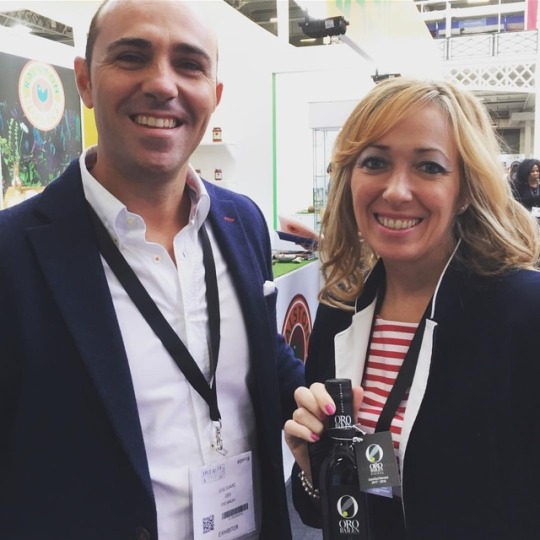
Ten years ago this week I met a Spanish food importer at the Speciality Fine Food Fair (@specialityfair) in London. 🇪🇸 Maria imported the fabulous @orobailen extra virgin olive oil and we carried that oil at @tastesdeli for eight years, until she retired. You might remember my excitement last winter when I found Yacine at the @artisanoliveoilcompany was now importing this delicious picual oil, and got it back onto our shelves. Well yesterday I was back at Olympia at the same show (now with it's own hashtag #sfff18) and was able to meet Jose, the producer of said olive oil! 😄 This is him, with his colleague and their oil! 😍 #excitingday #meettheproducer #oliveoil #extravirgin #picual #awardwinning #producer #networking #tastesdeli #eton #windsor #berkshire (at Tastes Delicatessen) https://www.instagram.com/p/BnT0FbbAjjO/?utm_source=ig_tumblr_share&igshid=53ub7hi1s5l6
#sfff18#excitingday#meettheproducer#oliveoil#extravirgin#picual#awardwinning#producer#networking#tastesdeli#eton#windsor#berkshire
0 notes
Text
Olives are a fruit and just like any agricultural crop, there are factors that affect the quality. This article is an overview of 12 main factors that impact the quality of the fruit juice (extra virgin olive oil).
1. Variety of the olive
The variety of the olive affects the composition, texture and flavor of the oil extracted from it. According to Tom Mueller, guru about truth in olive oil, there are more than 700 varieties of olives around the world. Spain has 25% of the entire olive growing area with more than 260 varieties.
One of the main compositions of olive oil, —and most important in terms of health and nutrition—, is oleic acid. As Uceda, Aguilera and Mazzucchelli point out in their book, Manual de cata y maridaje del aceite de oliva (Handbook for tasting and pairing olive oil), every variety offers different levels of oleic acid. And even within a specific variety, the composition of oleic acid will vary depending upon region, altitude, time of harvest, and extraction process. The Picual, and Hojiblanca varieties offer the highest level of oleic acid, compared to most other varieties. Picual and Hojiblanca are two varieties that are grown heavily in Andalusia, Spain.
But, oleic acid is not the only important element in top quality extra virgin olive oils. Many would argue that the sensory attributes are the most important thing. The look, taste and feel of EVOO are hugely important, and again varies depending upon the variety of olive. Some varieties produce a dark green oil, others an oil with a golden tone. Each offers a different set of flavors for the taste buds and a different structure (thin to rich). EVOOs that have a higher content of polyphenols (a fantastic natural antioxidant) also offer strong sensory attributes of bitterness, pungency and scratchiness, which may not be enjoyable to all palates. The Picual variety offers medium-high contents of polyphenols, and Hojiblanca, medium-low content. Comparing a top quality picual EVOO along side a top quality hojiblanca, you will find that the latter is a tad smoother to the palate without loosing the distinctive end bite.
GringoCool varieties of extra virgin olive oil are Picual (organic) and Hojiblanca, the two varieties that have the highest composition of oleic acid (more than 70%). Also, the content of poliphenols known for its antioxidative qualities, make them a very stable olive oil, with a longer quality life span. Picual is the most stable of all varieties.
2. Location
The location where the olive trees grow is a factor that can affect the composition of an olive oil. Sunny days, precipitation and soil quality are some of the ingredients leading to a successful harvest. You can’t grow olive trees in the Artic, or at least in natural conditions. Each agricultural crop, whether it is peanuts, potatoes, grapes or olives, has minimum requirements for the fruit or vegetable to be produced. … I know it is pretty elementary, but some locations are better for some crops. The Mediterranean basin is ideal for olive production. Southern Spain especially, is ideal for olive production. On a regular basis, more than 45% of the world’s olive oil is produced in Spain.
Some varieties are more hearty than others and location/conditions have a lower impact on the fruit production. One of the varieties that is most affected (or least “plastic”) is Arbequino. Studies have shown that depending upon where the tree grows can affect the content of oleic acid in Arbequino harvest from 75% (in Cataluña) to less than 55% in some orchards of Argentina. The content of polyphenols can as much as triple from one location to another, and the polyphenols are the basis of the sensory attributes. So in one location, you might produce a wonderful EVOO and the same variety in another location might produce an oil that doesn’t qualify as EVOO.
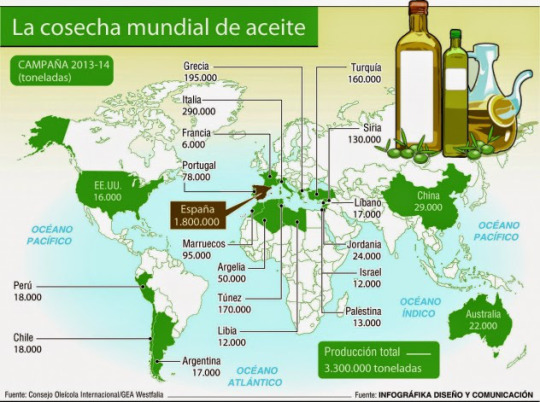
2014 Olive Oil Harvest World Wide (in tons)
Our GringoCool varieties of picual and hojiblanca are grown near Cordoba, Andalusia, in terrain and conditions that produce the highest quality of EVOO.
3. Agricultural techniques
I always get a kick out of some of the European marketing to US customers. Many of the “Italian” and “Greek” brands of EVOO, suggest they are produced by “Gramma and Grampa Bambino”, in their back yard orchard, and the olive oil is natural because it is pressed under their feet the way their ancestors made it, etc. etc. They market an idea that the best quality is almost artisan or homemade. And I put “Italian” and “Greek” in quotes because there are a lot of these companies that buy Spanish EVOO in bulk and then bottle and label it as their own.
Spaniards don’t buy into that because they know good quality EVOO, and they know it is not produced in Gramma’s back yard. A good comparison is wine. While it might be fun to taste Gramma’s backyard moonshine, if you are looking for a good quality bottle of wine, you purchase it from a respectable winery.
You will notice on all the labels of top quality Spanish extra virgins, the phrase:
“Aceite de oliva de categoría superior obtenido directamente de aceitunas y sólo mediante procedimientos mecánicos” which translates as “Superior category olive oil obtained directly from olives and solely by mechanical means.” No grubby hands and feet involved.
The best olive farmers produce the best extra virgin olive oil. Good farming involves the right varieties of olives, timely and appropriate pruning, timely harrowing or disc-ing to preserve ground moisture, timely and appropriate irrigating, fertilizing and pest control. There are few secrets to good farming, mostly it takes a lot of knowledge, experience, dedication and hard work (and a little luck and cooperation of Mother Nature).
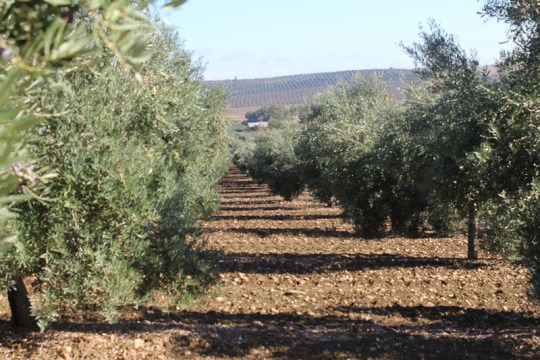
Olive orchard near Cordoba, Spain (for the production of olive oil)
Olive orchard near Valencina de la Concepcion. These trees produce the “gordales” that are popular as appetizers in Spain. Table top varieties are hand picked – different from olives harvested for olive oil.
Hand picking gordales for the tabletop, near Seville

4. Harvest
The olive harvest season in Spain usually starts in October and is finished by the end of December. The maturity rate of the fruit will vary according to conditions of the season (e.g. wet or dry) and location (e.g. altitude). Many factors are involved in a harvest, and not the least important is the production capacity of a molino (olive oil mill).
There are many, many small property owners in Spain and olive trees are part of the culture, tradition and heritage. Many families maintain their “link to the land” by keeping a couple of hectares of olive trees. The harvesting is a seasonal opportunity to meet up with old friends, and stand around “swatting flies and kicking tires”.
You can smell the harvest in Andalusia. It is a lovely time of the year. Driving the country roads in the fall evenings, a lovely aroma drifts about, associated with the picking and transporting of the olives.
In Spain there are two types of molinos or mills where the olives are processed and turned into olive oil. The first type is private mills. In many cases, the private molinos are owned and operated by a family and in other instances, large corporations. The second category of mills is ownership by an “association”. Usually, an association is formed of many small land holders in an area, and it allows cost sharing of the purchasing and maintenance of the equipment, as well as the operation of the mill. Also, many times the associations will take the lead on labeling, marketing and selling the product each year. An association provides the opportunity for small land owners to make a profit.
Each mill will have a daily production capacity, like any factory. To be profitable and to produce the best quality olive oil, the harvest must be orchestrated. Specific varieties of olives mature more rapidly than others. Many times, it is more profitable to produce a single variety extra virgin olive oil (such as picual, and hojiblanca), and in other instances a blend of varieties is used to produce the olive oil. You have to imagine that each mill is surrounded by fincas (farms) and olive orchards. There has to be a plan and a sequence to the harvesting, so that all the olives are harvested in an order that best permits the production of top quality olive oil. This is no easy task.
This is where the “catador” comes into the picture. Each mill will have at least one catador who acts as the director of the orchestra. This person determines the sequence of the harvest and the sequence of olive oil production at the mill. Prior to the harvesting (during the spring and summer), the catador visits the fincas, registering the varieties, condition, expected yields and maturity of the fruit. This data along with logistical considerations of moving teams/equipment, is used to plan the harvest.
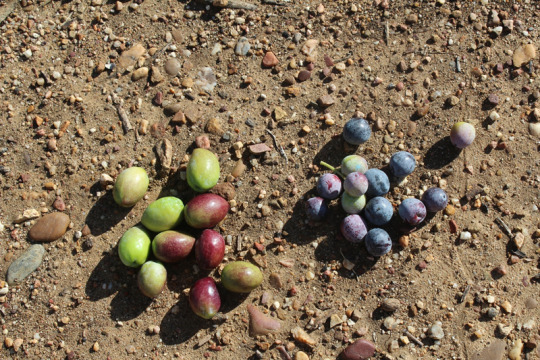
Two varieties of olives destined for the mill.
Some varieties mature earlier so they are harvested first. If single variety olive oil is the goal, then the catador must coordinate the harvesting and delivery of the same variety from several different harvesting locations.
This grows more complicated as mills work to fill their capacity and calendar. Usually, each private mill will have a limited number of hectares that the family owns. So, the mill will make agreements to purchase the olive production at other fincas, not owned by the family. Or, mid-size or larger olive orchards, may make an agreement for delivery to the mill at a specific date for the production of their specific brand of EVOO.
In the meantime, there are always a few Grampas that show up at the mill with their old tractor or jeep and one cart of olives (or several gunnie sacks). So the mill has to plan for the reception of local production as well as the large sequenced harvests of orchards.
And rain. If it rains during the harvest season, it pushes the harvest back. The plumpness of the olive is important to produce the best quality. An olive overly plump after a rain will produce a lower quality EVOO.

5. Timing
The quality of EVOO produced during a harvest season follows a bell curve. The very best extra virgin olive oil is usually produced in the middle of the season when the content of polyphenols peak. Again, the polyphenols provide the sensory attributes of EVOO (i.e. composition, texture and flavor). The earliest olive oil produced in the season is called “verde” or green, and usually has a fresh, green flavor that is quite strong. Towards the end of the harvest, a lot of the olives may be overly mature and plump, reducing the content of oleic acid and pholyphenols, leading to a less flavorful EVOO.
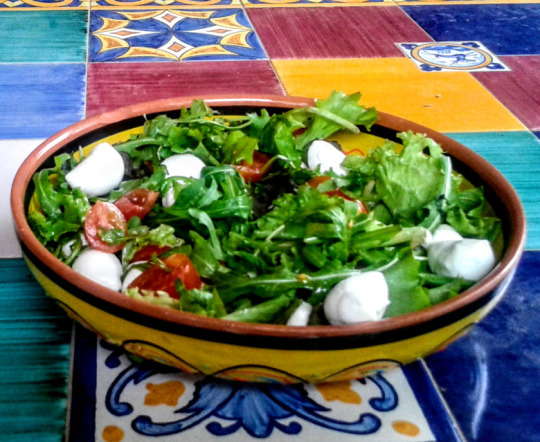
A fresh salad finished with delicious and healthy Spanish extra virgin olive oil
Extra virgin olive oil must meet specific criteria to be classified as extra virgin. It is only the very best quality of the harvest, offering the best flavors, consistency, and health benefits.
Virgin olive oil is the next category down. The olive fruit will not be the same quality as those harvested to produce the extra virgin variety. The fruit are still processed in the same way (first cold pressed), but the quality in terms of oleic acid and polyphenols, will be of lower quality.
Olive oil is the lowest quality produced during a harvest. This is refined by using acids, alkalis and heat to extract the oil from pulp remaining of earlier production runs. Olive oil offers little in terms of taste, aroma and natural antioxidants. Many times this type of poor quality olive oil is sold under labels declaring “pure” or “100% pure” or “Light”.
Always, …always read the label and buy your EVOO from a source you trust!

6. Transportation
The speed of conversion from picked fruit to fruit juice impacts the quality produced. The shorter the period between when the olive leaves the tree and when it is cold pressed, the better and truer the quality of EVOO. In the best mills, the olives are picked/harvested and within four hours are cold pressed at the mill and the juice stands in temperature controlled, stainless steal tanks.
To achieve the shortest transport time, it is important to have the best methods for transporting the olives to the mills and usually this involves trucks. A lot of time, bins are used in the fields, which are then emptied into trucks, which then go to the mill and dump.

Reception of harvested olives
Smaller producers may have smaller crews and slower transporting machinery. They may half fill a tractor/trailer unit in the afternoon, then go home for the night, coming back the next day to finish filling the trailer. Olives begin to deteriorate when they leave the limb.
For this reason, mechanized methods are used for harvesting. Hand picking is too slow. And mixing olives that haven fallen and lain on the ground with those picked directly from trees, lowers the overall quality of fruit. Again, some mills will process a lot of gunney sacks (burlap bags), of olives transported to the mill by individuals or small property owners. It is harder to control the quality of small quantity deliveries.

Trucks are better than burlap bags

7. Sorting & Cleaning
When the olives arrive to the molino they first must be sorted and cleaned. There will always be a certain amount of leaves, twigs and branches that need to be sorted off. And, there are always a small percentage of olives that shriveled on the tree, and they need to be sorted off before the olives are cold pressed. The mill must have the appropriate machinery for receiving, sorting and washing the olives if top quality EVOO is the goal. The best mills have mostly stainless steel machinery, which facilitates the cleaning between production runs.
Olives to be cleaned
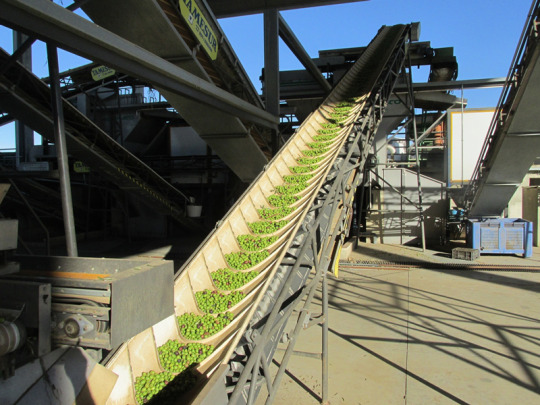
Sorting of Spanish olives

8. Storage of the Olives
First, olives should not be stored. The olive should be cleaned and cold pressed as soon as possible after harvested from the tree. Storing olives is a no no. The mill has to have a clear plan for processing the olives as soon as they receive them. They cannot sit around or they begin to ferment and the quality of the EVOO drops.
Bins for the sorting of varieties or quality, before the cold press

9. First Cold Pressing
“First Cold Pressed” is a phrase that has caught the attention, if not the understanding of the US consumer. Our GringoCool brand of Spanish extra virgin olive oil is for sale at our online store (gringocool.com), and also via amazon and several of our customers have written reviews to the effect that our EVOO is good but it is “cold pressed” and NOT “first cold pressed”. As the owner/operator of GringoCool, I have taken the time to write back and point out that all “extra virgin olive oils” are by definition “first cold pressed” or “cold pressed”. This phrase refers to the fact that the EVOO is the juice produced as the olive is crushed, ground and the olive oil extracted via a centrifugal machine. Another important detail is that at no point during the process can the temperature rise above 26 degree Celsius.
“Olive oil” on the other hand, is produced not from the first cold press, but instead from the pulp remaining from the first cold presses and it is refined at times in high temperature processes which actually change the qualities of the olive oil.
No substitute for good machinery and cleanliness in the production of EVOO

10. Centrifugal process
There is no substitute for modern, up-to-date machinery for extracting the best quality extra virgin olive oil.
The best olive mills today are computer programmed, controlled and monitored. Each delivery is tracked from the point of reception to the final storage in temperature controlled stainless steel tanks. The process is completely mapped, controlled and registered. Modern mills record the harvest date and time, harvest location, as well as the processing and specifications of each litre produced. Each year this information is more necessary to combat the olive oil fraud perpetrated by dastardly desperados that purchase in quality EVOO in bulk, and then add other oils such as canola, sunflower, etc along with coloring, – before labeling it and selling it as extra virgin olive oil.


11. Hygiene
Everyone knows that cleanliness is important to quality. But it takes dedication and discipline to really go the extra yard and keep the mill and processing clean. I have been in some very “iffy” mills, where you become scared to peer into corners for what you might discover. It is very easy to let things slide in a factory environment, and only the very best mills stay disciplined and produce the highest quality of EVOO.
Clean surfaces are important for quality – which means hard work and dedication to details

12. Storage of final product
Temperature controlled stainless steel – no other answer for the storage of EVOO. Gramma’s wooden barrels just don’t cut it. Haha.

First stop in the Molino. Mixing can occur here if a mixed variety of EVOO is the goal
From the reception patio to the stainless steel tanks is a path of two to three hours approximately. The stainless steel tanks store fresh olive juice and the centralized computer registers the harvest location, time and crop attributes for each of the tanks. Each step in the process is strictly controlled in the production of high quality EVOO.

Conclusion
There are many factors that impact the quality of extra virgin olive oil. Here I have provided a breakdown of 12 factors. There are many articles and blogs to be written about the production of EVOO. Here at GringoCool, we are interested in diving into other areas regarding the production, bottling, exporting and selling Spanish EVOO.
Each year, I think it is more and more important that brands provide security to their customers so that they feel comfortable with their purchases. There is so much olive oil fraud in the market that it can be tough to trust a brand without learning some of the nuts and bolts. I believe it is important to lay out what is involved in the production of olive oil and to provide a guarantee that customers receive only the highest quality product.

GringoCool Guarantee
You will never always receive top quality, Spanish extra virgin olive oil. There will be no middlemen. The EVOO will be carefully selected, bottled, and then shipped to our warehouse in Oregon, where it is sent out to our customers (or amazon fulfillment). Rest assured you will never receive a watered down concoction, posing as an extra virgin olive oil from GringoCool. You will always receive the real deal .
GringoCool will endeavor to provide our customers with the best information, recipes, customer service and product we are capable of bottling.
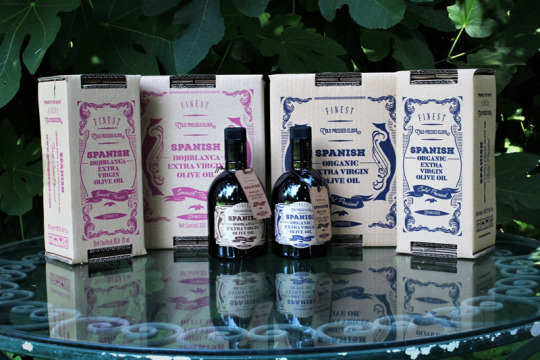
Our 100% certified organic picual and conventional hojiblanca only available from GringoCool
———————————————–
Thanks so much for reading. We welcome comments and emails.
Please have a look at the info graphic produced by our wonderful Pia at GringoCool. If you find it helpful, please share it and also please tell your family and friends to check out gringocool.com for the real deal EVOO.
Happy eating. -Steve

12 factors that affect the quality of extra virgin olive oil Olives are a fruit and just like any agricultural crop, there are factors that affect the quality.
0 notes
Text
Buy Spanish Picual Extra Virgin Olive Oil
Indulge in the rich flavors of our Spanish Picual Extra Virgin Olive Oil. Sourced from premium olives, this exquisite oil elevates your culinary creations. Elevate your dishes with the authentic taste and health benefits of this liquid gold. Buy now and savor the essence of Mediterranean excellence.
0 notes
Text
Choosing the Best Extra Virgin Olive Oil
Gourmet Living sells extra virgin olive oil under its own label. Our products are sourced and bottled in Spain, Italy and California.
Sadly, most “extra virgin olive oil” sold in the United States and many other countries does not meet the standards adopted by the International Olive Council (“IOC”).
While olive oil “blends” are perfectly acceptable under IOC standards, unscrupulous companies misuse the “standards” and lax controls to misrepresent their product to the consumer.
While there is no right answer in choosing the “best” olive oil for you, the video below helps explain some of the key elements in choosing one where the quality and price point suit your palette.
youtube
Remember that olive oil is a juice. Like wine, the taste of olive oil is dependent on the olive variety, when it was harvested, soil and climatic conditions and how (and when) the olive was pressed, filtered and bottled.
I like olive oil with a little personality and prefer oils with a fruitiness and peppery aftertaste. Nevertheless, a reviewer of one of our products suggested that the olive oil had a “green” taste. Personally, I prefer to experience the “taste” and “aroma” of the olive in the oil, but others may be looking for something less fruity.
There are no “right” answers in choosing an olive oil, which is why we suggest choosing several varieties and make up your own mind. Found below are three distinct olive oils that we regularly use in our cooking.
We tend to use the California Picual for quickly sauteing pork and chicken, the Tuscan blend for vegetables and pasta and the Spanish Arbequina for salads. Of the three, the Arbequina tends to have a slightly more elevated flavor profile generally preferred by Europeans.
Like wine, each olive oil has its own distinct flavor profile. Don’t be afraid to experiment.
To learn more, consult Gourmet Living’s FAQ on olive oil.
Share
The post Choosing the Best Extra Virgin Olive Oil appeared first on .
from WordPress http://ift.tt/2zBxdLE
via IFTTT
0 notes
Text
Buy Craft Dark Chocolate
Experience the Richness of Craft Dark Chocolate. Choose from a variety of delectable options, perfect for any chocolate enthusiast. Buy Now!
1 note
·
View note
Text
There are three tricks to preparing garlic shrimp. First, you must use enough garlic. The dish is a garlic dish as much as a shrimp dish. Second, you must use a high quality extra virgin olive oil, and don’t be shy with it. The third tip is to cook at a low heat and be sure and not overcook the shrimp.
This is a simple dish and very representative of Andalusia and Spanish cuisine. You will find it in many restaurants. Normally, this dish is chosen as an appetizer or tapa, and is enjoyed along with a glass of beer or wine.
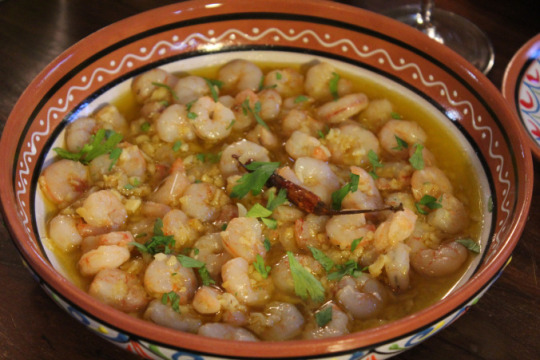
Gambas al Ajillo (Spanish Garlic Shrimp)
The best part of this dish is the caramelized garlic and shrimp juices that settle in the bottom of the pan and less about the shrimp. Be sure and have some fresh bread available to soak up the sauce.
Here is a recipe created by our own Manuela Augusto Cobos. Manuela has a lovely kitchen filled with fresh vegetables, herbs and spices. She has been kind enough to share with us a simple recipe.
Spanish Garlic Shrimp
Time:15 minutes
Effort: easy
Yield: 4 servings
Ingredients:
1/2 cup olive oil
half of one giant head of elephant garlic, roughly chopped
1 teaspoon Spanish paprika
a chili pepper whole
1 pound of shrimp, peeled and de-veined
salt to taste
1 tablespoon minced parsley to garnish
Directions:
– Put your oven rack in the middle position and heat to 400 degrees F (200 C).
– Add the oil and garlic to a cast iron pan and heat over medium high heat. Fry the garlic until it starts to turn brown around the edges. Add the Spanish paprika and the chili pepper, and stir to combine.
– Add the shrimp in a single layer, and then sprinkle with salt. Put the pan in the oven and cook until the shrimp is pink and opaque all the way through (about 2-3 minutes).
– Remove the pan from the oven and sprinkle with the parsley. Toss the shrimp to coat with the oil and serve with bread.
#gallery-0-5 { margin: auto; } #gallery-0-5 .gallery-item { float: left; margin-top: 10px; text-align: center; width: 50%; } #gallery-0-5 img { border: 2px solid #cfcfcf; } #gallery-0-5 .gallery-caption { margin-left: 0; } /* see gallery_shortcode() in wp-includes/media.php */
Don’t be shy with the garlic (crushed, chopped and minced)
Ready to roll!
The quality of the extra virgin olive oil is what will make or break this dish. The flavor is principally the cooked garlic and olive oil. The “sauce” is primarily olive oil. So if you use a nice variety of extra virgin, you can expect outstanding flavor.
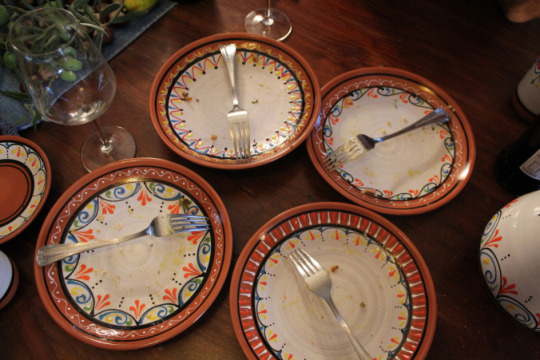
I can’t believe I ate the whole thing!
Here at GringoCool, we offer two varieties of top quality, Spanish extra virgin olive oil. Either would be wonderful for this dish. Our olive oils are carefully selected for body, color, flavor and quality. Our extra virgins are bottled especially for this type of cooking – where the flavor of the olive oil is an attribute. Our olive oils are for finishing food, or slow cooking.
We are kicking off the 2017 holiday season with a special offer of 25% off of either our Spanish Hojiblanca, or our Spanish, 100% organic Picual extra virgin olive oils. You will not find that price anywhere except at our online store (gringocool.com). This is a limited time offer.
Thanks for reading and let us know about your experience cooking Spanish garlic shrimp!

Spanish Hojiblanca and Spanish 100% Organic Picual from GringoCool
Garlic Shrimp (Gambas al Ajillo) Recipe There are three tricks to preparing garlic shrimp. First, you must use enough garlic. The dish is a garlic dish as much as a shrimp dish.
0 notes
Text
The 2017 summer was hot and dry here in southern Spain. Not much precipitation at all…… which bodes well for fans of flavorful Spanish extra virgin olive oil.
Just like any other fruit, when there is an abundance of moisture during the growing season, the fruit becomes fat and juicy and the olive oil extracted is less flavorful and less concentrated. This year, the fruit is smaller and the juice will be more robust.
The first harvests are underway in the fincas of Andalusia and the fruit still is slightly green or “verde”. The first cold pressed, extra virgin olive oil that comes out of the green, less mature fruit is very strong – very similar to the juice produced by early apples or oranges. Some people here in Spain will only consume the earliest olive oil produced during a harvest because they like a very strong flavor on their toast, pasta, vegetables or salads.
Yesterday, I visited the olive oil mill Alamazara 1945 and Victor and Pepe gave me a sample of the earliest of the earliest olive oil of the season. I tasted it and it has a lovely, fruity bite. I can’t wait to try it on my breakfast toast tomorrow, and then on a salad in the evening.
Secret combination
The vault
Pepe,… with the elixir of health
Yum, yum, … can’t wait!
I work with Alamzara 1945 in the selection and bottling of GringoCool olive oils. They are located near Cordoba, in the heart of olive country. They are a family managed olive oil mill that produces one of the very best quality of extra virgin olive oil in Andalusia.
In this new season, I will start working with Victor and Al Margen in creating a sampling packet with four varieties of Spanish extra virgin olive oils, … possibly even including a “verde” in the packet. I am looking at including an organic picual, an hojiblanca, an arbiquino and a “verde”. The samples bottles would be 250 ml (8.5 fluid oz) and would allow GringoCool customers to sample and compare Spanish extra virgin olive oils. This is important because the flavors of some olive oil varieties compliment certain types of food more than others.
As of right now, GringoCool has two varieties of extra virgin olive oil for sale in the US – an organic picual and a conventional hojiblanca. They were both carefully selected for flavor and body. We aim to provide the very best quality and value. After our olive oil is bottled and packaged, we ship it directly to our warehouse in Oregon. And then it goes to our customers tabletops via the United Post Office. No middlemen… period. You get the real deal, quality assured.
We do not spend time, money and effort in attending international award festivals. Awards don’t mean much anyway, because they are only based on one bottle at one time. Instead, we put our effort and our money in the product and getting it to market and your tabletop as quickly as possible. Our bottle is a wide bottomed vessel of dark glass, which improves the tabletop stability and protects the olive oil from direct sunlight. Our packaging is designed to ensure safe shipment through the mail or by carriers. Our labeling is simple, with craft paper. We want to provide the very best quality of product at the lowest price possible. No bells and whistles… just quality.
Check out our Spanish extra virgin olive oils at www.gringocool.com. We are working at being your trusted source for only the very best Spanish extra virgin olive oil.
Thanks for reading. And have a great day. – Steve
p.s. This season we will be sending samples of our extra virgin olive oil with purchases of pottery. I can not wait to hear from out customers and see if this is something they like.
The 2018 Olive Harvest Has Begun in Spain The 2017 summer was hot and dry here in southern Spain. Not much precipitation at all...... which bodes well for fans of flavorful Spanish extra virgin olive oil.
#cooking#Cordoba#EVOO#extra virgin olive oil#international trade#organic#recipe#Spain#Spanish cuisine#spanish olive oil
0 notes